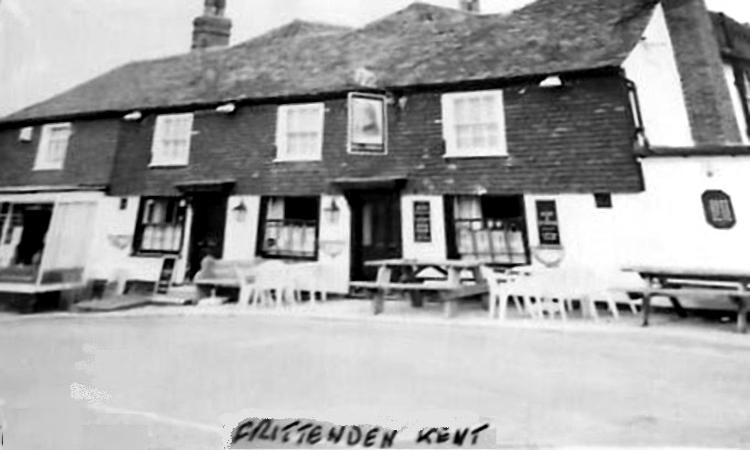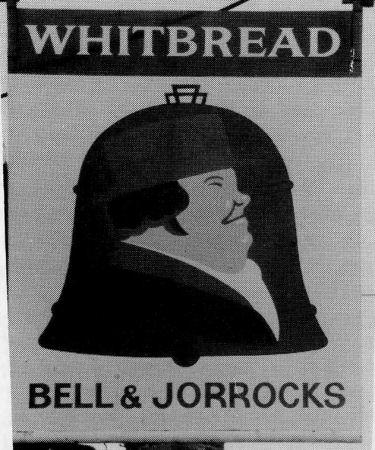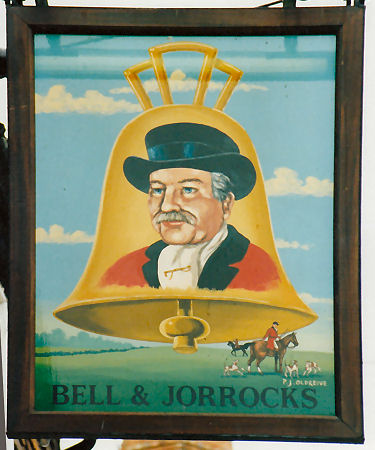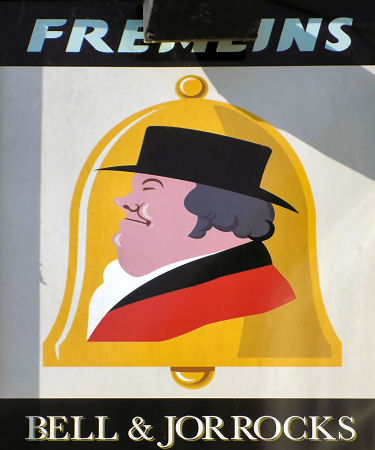|
Above information taken from
http://www.thebellandjorrocks.co.uk 9 March 2014.
THE BELL AND JORROCKS, FRITTENDEN
This building is grade II listed, the listing being
for the group of buildings around the crossroads in Frittenden village centre. It is described in the Kent Historic
Buildings Index as being 18th Century. The building
forms a block with Frittenden Stores and Manchester House, described as
"early 19th century."
The earliest documentary evidence for this building is an
indenture dated 8 May 1741. The building
itself appears to date from the early decades of the eighteenth
century. Whether there was another
building on the site before this date is unknown. The building block
today consists of both the pub and
the shop. However, originally the site would have consisted only of the
pub and its outbuildings of stables
etc. The shop was built about one hundred years later. The 1806 Tithe
Map shows the pub on an island
site with the road passing in front of the building as today, but with
another track passing in front of Forge
Cottage and behind the pub, passing through where Hepplewhite stands
today.
The indenture of 1741 was between Moses and Mary Lepper and
William Serjeant, and John and Lydia
Lepper and Thomas Lepper, and finally John Paine. Paine was probably the
tenant. Eleven years later,
in 1752, John Paine was in dispute with the other parties of the 1741
indenture.
Later that year John Grove (sometimes Growe) appears to
have replaced Paine having bought the "Bleu Bell" from John and Thomas Lepper, both described as carpenters from
Frittenden. The property consisted of the stable, outhouses, bankside
or orchard and also one spot of Ground being the nine pin alley
co-joining the orchard of John Weston.
John Growe, now described as a
yeoman of Headcorn, sold the "Blue Bell" to Thomas Ballard, a gentleman of
High Halden in 1769. Richard Baker is described as the occupier in
that document.
Following the death of Thomas Ballard in 1789 ownership transferred to
John Ballard, snr., and John
Ballard, jnr., both stable keepers from Middlesex.
Documents of
November and December 1803, show that The "Bell" was sold by the Ballards
to Robert
Tolhurst of Frittenden, turner. William Southon is shown to be the
occupier. By 1806 Tolhurst, who
now appears to be living in Biddenden, sells The "Bell" to James Dodson,
brewer of Cranbrook, apparently
with a mortgage of £250. William Potter is now described as being in
occupation.
By 1811 Dodson is described as brewer, dealer and cheapman and bankrupt. The
"Bell" was sold to
James Small, yeoman of Frittenden, who appears to have redeemed the
mortgage for £170. Of particular
note is the description of the property as all that one messuage or
tenement now or hertofore called or known by the name or sign of the
"Bell" with the shop stables and outhouses thereunto belonging some
time since altered and built by Robert Tolhurst together with the
cartside or orchard and all and singular
the appurtenances ... . This appears to indicate the building of the
shop and Manchester House during
the 3 year ownership of Robert Tolhurst. The document also refers to a
Richard Baker as the heir of
Robert Tolhurst. Whether this is the same Richard Baker who occupied
the "Bell" in 1769, or a relation,
is not known.
In 1818, James Small and Andrew Dungey took a mortgage on The
"Bell" of
£250. Small is described
as an Innkeeper of Frittenden and Andrew Dungey a ginger bread maker in
Cranbrook. Then, in 1821,
Small and Dungey sold The "Bell" to Samuel Shepherd, Gent., of Faversham,
for £800.
There followed a long period under the ownership of Samuel
Shepherd, one of the Shepherd Neame
dynasty. The 1839 Tithe Commutation Schedule indicates that The "Bell" and
premises were in the
ownership of Messrs Sheppards (sic) of Faversham and the tenancy of
Thomas Busbridge.
Busbridge was still the tenant of The "Old Bell Inn"
at the time of the 1841 Census. Busbridge was aged 50 but no wife is
recorded in the Census, although two daughters, aged 8 and 4, and a son,
aged 7,
are listed. There was a live-in female servant, Lucy Simmons, aged 55.
The following year, 1842, The Maidstone Journal and Kentish Advertiser
ran an advert for an auction to
be held by Mr Benjamin Hatch on 1 November. The properties were
described as very valuable
freehold and leaseholds at Tenterden, Wittersham, Halden, Woodchurch,
Lydd, Old Romney, Frittenden, Biddenden, and Goudhurst, consisting of an
excellent Brewery and several Taverns, Alehouses, Land,
&c., late the property of Samuel Shepherd, Esq., deceased, and by his
will directed to be sold. Lot 9 was The "Bell" Public house, with Garden,
Stable, and Outbuildings, at Frittenden, in the occupation of Mr
Busbridge.
The same newspaper recorded in May 1846 that the new
landlord of The "Bell" was a Mr G Price. The
article was about the anniversary of Frittenden Provident Benefit
Society, founded in 1839: the
celebrations included a dinner at two o clock, some four hours after the
festivities began, for 120 gentlemen and members, provided by Mr Price,
probably in what is known as the Bell Field today.
An 1848 Directory of
Kent shows George Price not only as victualler at the "Bell" but also
as a shopkeeper.
The 1851 Census shows George Price, aged 31, as grocer
and innkeeper. He lived at the Inn with his
wife Ann, 31, and son George, aged 8 and described as a scholar. The
household was completed by
Mary Nye, 21, house servant, and Mary Cox, 18, draper's assistant.
Later, Price was to move to Lake House where he farmed about 17 acres in Frittenden and Staplehurst with a rental value of £96.18s.
However,
by 1861 the Census records James Barton, 48, Innkeeper and Carrier at
The "Bell Inn." An
1848 Directory notes that James Barten (sic) operated a carrier service
between Frittenden and The "Ship"
at Maidstone on Monday and Thursday. The census of 1841 and 1851
recorded Barton as a carrier,
operating latterly from Hollenden Cottage close to The "Bell." As the
local inn was often the meeting/pick-up point for a carrier, it would have made sense for Barton to combine
the role of Innkeeper and carrier,
particularly as The "Bell" also possessed stables. Barton lived with his
wife, Eliza (44), together with a son
James, 20, and Harriot, 12. Another daughter, Elisa 24, also lived at
The "Bell" with her husband James
Harris, 24, a carpenter.
In 1863, another large brewer appeared on the scene when The
"Bell Inn"
was leased for 21 years by Price
to Messrs John Brenchley, Edwin and John Stacey of Maidstone. This
would appear to be the
beginning of the association with Messrs Isherwood Foster & Stacey,
brewers of Maidstone. The 1863
document indicates that James Barton continued as tenant at a rental of
£40 per annum.
An indication of the perceived permanency of the public
house as an institution is given by the placing of
a benchmark on the front of The "Bell Inn" in 1866. This indicates the
elevation of the village at 116.96 feet
above mean tide at Liverpool. This is recorded as having been
authenticated by H. S. Palmer, Captain
R.E.
The 1867 Kelly s Directory for Kent records that William Brakefield was at The
"Bell." He was described as
also being a butcher and carrier. This was confirmed by the 1871
Census when Brakefield lived at
The "Bell" with his wife Louisa, 51. However, his household was quite
extensive with 5 men, all described
as servants, living-in. Thomas Hodges, 41, James Brenchley, 16, and
James Gurr, 14, were all described
as labourers, and Alfred Gurr, 38, possibly the father of James, was a
shepherd. James Morgan, 20, was
a butcher's assistant.
By 1874, the Post Office Directory shows a
William Kemp at the "Bell" and in October 1875 Dive Bearsby,
snr. took on the tenancy. Kelly's Directory of 1878 shows a Charles Bearsby at the
"Bell" but this is an
error.
In 1880 Dive Bearsby, jnr., was born in The "Bell." The Census of 1881
confirms Dive Bearsby, 42, as the
innkeeper of the "Bell Inn." Living with him were his wife Adelaide (44),
daughter Alice, 10, and sons
Frank, 7, Peto, 3, and Dive, 1. A female general domestic servant,
Florence Thomas, was also recorded,
as was Thomas Croucher, 42. Perhaps surprisingly, given the nature of
the business and the presence
of stables behind the Inn, 1881 was the only census where an ostler and
inn servant was recorded,
Samuel Clapson, 49.
The continued occupation of the "Bell" by Dive Bearsby,
snr., as innkeeper was confirmed by entries in
various directories and by the 1891 Census. However, by this date
the household shows a distinct division between the household in the Inn
and that of the shop. Dive snr., now 57, was accompanied by
Alice, now 20, and Dive jnr., now ten and described as a scholar.
However, Dive, snr., now appears to
have a new wife, Sarah, 45, and a new son, Arthur, aged 2, his first
wife, Adelaide having died in April
1885. Percy Shoobridge and his wife Mary are described as Drapers
and have their own, apparently
separate household in the shop.
The Club Day of Frittenden Provident
Society was again reported in the local press in 1894. At two o'clock
the members dined together in a large marquee erected in a field near
the "Bell Inn," where an excellent spread was, as usual, prepared in a
most satisfactory manner by Host Bearsby.
Dive Bearsby, snr.,
remained the innkeeper at the time of the 1901 Census. His household
consisted
of Sarah, his wife (55), daughter Alice, 30, and four sons; Frank (27),
Dive (20) from his first marriage and
Arthur (12) and Charles (9) from his second. Only one servant is
recorded in the Inn, Helen Murrell (16),
described as a general servant. James Ashbee is now operating as a
grocer and draper in Manchester
House.
At the time of Dive jnr's wedding to Florence Chantler, of
Parsonage Farm, in April 1904, Dive snr., by
now 63 years of age, is described as retired inn keeper and Dive jnr.,
aged 23, as Inn Keeper, The "Bell
Inn," Frittenden.
Dive junior kept up the tradition of multiple
occupations of the innkeeper of The "Bell." At various times
he farmed at Whitsunden and at Street Farm. During WWI he served with
the Royal Flying Corps in
France.
A comedian who once stayed at the "Bell Inn" on holiday, took away
many jokes about the Frittenden Band
Chaps, some true, some fabricated. One long-established yarn
concerned a diminutive drummer
whose big drum so obscured his vision that he was once found marching
along by himself, beating his
drum for all its worth, blissfully unaware that the rest of the band had
turned down a side street! Another
story has it that one of the men, on the auspicious occasion of a visit
of the Band to London, was so
enthralled by the sights around him, that he lost his mates, but very
soon accosted one of London s policemen who, he thought, would be sure
to put him right straightaway, hence his question, "Seen
anything of them Frittenden Band chaps?"
The local press reported
the 1908 anniversary of the Frittenden Provident Society taking place,
the
69th. On this occasion it is reported that members met at the "Bell
Inn" and transacted business at ten
o'clock. After a church service and parading the village, at two o'clock
a capital dinner was provided. About 250 enjoyed the excellent repast
provided by Host Bearsby. The link with the Provident Society
was reinforced when, in 1911, the Club House was erected to the rear of
The "Bell." It became not only the
focal point of the Society but much of the social life of the village as
a whole.
Dive Bearsby, snr., died 3 August 1920, almost 45 years after
entering The "Bell." He is buried in St Mary's churchyard along with his
first wife Adelaide. The local press reported his death as being
that of a
well known Weald sportsman.
By 1935, Fremlins had taken over the
freehold and in that year a picture of The "Bell," decorated for the
Silver Jubilee, confirms this.
June 1939 saw the closure of the Frittenden Provident Society and the beginning of a change in the role
of The "Bell." The "Bell" and the Club Room had been the location of many
village activities and the Club
Room had been the centre of the Provident Society. The "Bell Inn" Slate
Club was another self-help club associated with the pub. Many other
institutions met at The "Bell." The Poor Law records show that
the overseers had, over several centuries, met at The "Bell." However,
the Poor Law had been
abolished in 1929, although it's impact continued until the creation of
the welfare state effectively from 1948. The Vestry had been the main
tool of civil administration until the creation of Parish Councils in
1894. Minutes of Vestry meetings often record that the meeting began in
the Church but often adjourned
to complete business in The "Bell." The Club Room had also been the
venue for events such as
Smoking Concerts, one such being advertised in May 1927. Other
events included political
meetings, the annual meeting of the bowls club, dancing
classes and various forms of
hunt. Perhaps one of the more unusual uses made of The "Bell" was as
the venue of the Coroners
Court.
One continuing use of The "Bell" and now The "Bell and Jorrocks" is
its use for the annual meeting of the
Feoffees of the Idenden Charity. This Charity was founded in 1566 to
distribute funds derived from the
legacy of Thomas Idenden to the use of the Poor Maidens Marriages, to
the relief of the poor Householders within the said Parish of Frittenden
and to such Deeds of Charity as shall be thought most
needful.
In 1956 a newspaper article noted that Dive Bearsby, jnr., was still
licensee at the "Bell," having clocked up
52 years. The directors of Fremlins entertained Dive to lunch at the
"Royal Star Hotel" to note the
achievement. The article concluded with the sentiment that he remain
licensee for The "Bell" for many years.
In 1963, the two village pubs were photographed. Both showing themselves
as Fremlin pubs. 1964 saw
the establishment of the Toucan Club by Bob Coram (the cartoonist better
known as Maroc) and others to
lobby for draught Guinness to be available in The "Bell." This was
ultimately successful.
In 1967, Fremlins were taken over by the brewers Whitbread and two years
later, in 1969, Dive Bearsby
retired as licensee after 65 years and 94 years after his father took
over the licence.
At this point plans were made to amalgamate the two
pubs in the village. The John Jorrocks, formerly
The "New Inn," was in the tenancy of Phil Oliver. With the amalgamation of
the two pubs, the John
Jorrocks was closed and The "Bell" renamed The "Bell and Jorrocks" with Phil
Oliver as the tenant.
During the Post Office strike of January 1971
The "Bell and Jorrocks" became the site of the Post Box for a
private postal service established in the village. This service
distributed local, national and international
post during the dispute. Stamps were designed by Bob Coram, Maroc.
Phil Oliver had been 57 by the time he moved into The
"Bell and Jorrocks"
and in 1978 the Tenancy was
taken over by Les Randall. The "Bell and Jorrocks" was again the recipient
of a significant village artefact
when, in 1983, a propeller blade from the Heinkel shot down close to the
village in 1940 was hung in the
pub, together with a dramatic painting of the event.
In 1986, the tenancy was taken over by Brian and Nikki Holloway. The pub
has been in their tenancy
since then until April 2006 when Sean and Rosie Croucher took over to
continue the provision of beer,
food and a social centre to the village of Frittenden into a fourth
century.
By Phil Betts.
|




